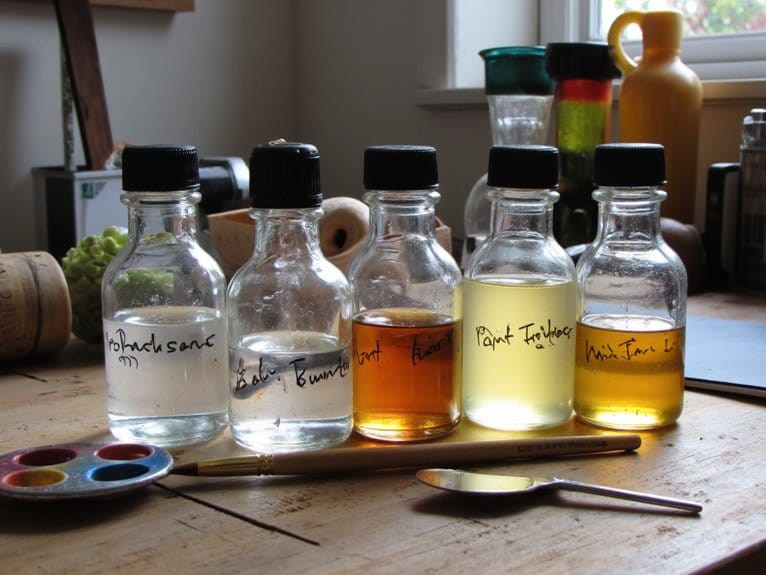We are supported by our audience. When you purchase through links on our site, we may earn an affiliate commission, at no extra cost for you. Learn more. Last update on 1st July 2025 / Images from Amazon Product Advertising API.
You’ll find three main varnish types for miniature protection: water-based varnishes offering low VOC levels and fast drying times, solvent-based options providing superior durability with potential yellowing, and acrylic formulations delivering flexible protection against cracking. Each comes in gloss finishes for maximum surface hardness, matte varieties for glare reduction, and satin options balancing protection with controlled light reflection. Understanding application techniques, environmental factors, and combining different finishes will maximize your miniatures’ longevity and visual impact.
Notable Insights
- Water-based varnishes offer low VOC levels and faster drying, making them ideal for indoor use and light-colored miniatures.
- Solvent-based varnishes provide hard, durable finishes with superior longevity but require good ventilation and may yellow over time.
- Acrylic-based varnishes deliver flexible protection against cracking and come in multiple sheen options for versatile applications.
- Gloss varnishes provide maximum surface hardness and impact resistance while creating realistic wet effects like water or blood.
- Matte varnishes reduce glare and offer softer protection, perfect for larger surfaces and creating muted background elements.
Understanding Gloss, Matt, and Satin Finishes
When choosing a protective finish for your painted miniatures, you’ll encounter three primary varnish types that each deliver distinct visual and functional properties.
Gloss varnish creates highly reflective surfaces that enhance color vibrancy and depth. You’ll achieve excellent gloss durability while mimicking wet effects, glass, and gemstones. However, this finish emphasizes surface imperfections and creates unwanted glare during photography.
Matt varnish produces flat, non-reflective surfaces ideal for tabletop gaming. It preserves color contrast without distortion and enhances realism for historical models. Photography results improve markedly with reduced specular highlights. Apply varnishes in multiple thin layers to avoid thick coatings that can obscure fine details. Matt varnish can dull colors slightly and may require additional coats for complete coverage.
Satin varnish balances both extremes through semi-gloss properties. Satin application provides moderate reflectivity without intense shine. Colors saturate more than matt finishes while maintaining detail visibility. This versatile option highlights textures subtly without flattening surfaces.
Spray Application Techniques and Benefits
You’ll find spray varnishing offers superior coverage consistency compared to brush application, making it ideal for protecting multiple miniatures efficiently.
Proper technique requires maintaining 25-30 cm spray distance while using sweeping motions that begin and end off the model to prevent buildup at start points.
Always work outdoors or in well-ventilated areas with protective equipment, as aerosol particles pose inhalation risks and require adequate airflow for safe application. Apply multiple thin coats rather than single heavy applications to achieve optimal protection without obscuring fine details.
Environmental factors like temperature and humidity can significantly affect drying times and final finish quality during spray application.
The varnish requires a full 24-hour curing period to reach maximum durability and protection effectiveness.
Even Coverage Techniques
Although brush application offers precise control, spray varnishes deliver superior even coverage across miniature surfaces through proper technique and equipment handling.
You’ll achieve matte consistency by maintaining ideal spray distance of 6 to 12 inches from your miniature. Start spraying off the model, then sweep across in smooth, continuous motions to prevent varnish buildup.
Apply multiple thin coats rather than single thick applications. This technique eliminates runs and drips while ensuring uniform protection. Allow each layer to dry completely before adding the next coat. The spray method reaches intricate details and recessed areas that brushes often miss.
Use well-ventilated spaces and wear protective equipment during application. Clean spray nozzles regularly to maintain consistent spray patterns for future projects. Monitor environmental factors carefully during application, as humidity and temperature can cause frosting effects that compromise the finish quality. Apply two coats for enhanced durability when maximum protection is needed for frequently handled gaming pieces.
Batch Processing Efficiency
Processing multiple miniatures simultaneously through spray varnishing transforms your workflow efficiency and delivers consistent professional results across entire collections.
You’ll achieve uniform coverage across dozens of models in minutes rather than hours required for brush application.
Effective batch organization requires grouping miniatures on holding sticks or temporary mounts.
Position models 6-8 inches from spray nozzles for peak atomization.
Test spray patterns on cardboard before applying to verify proper pressure settings and finish quality.
Process standardization eliminates variables that cause inconsistent results.
Sequence batches by model type to minimize equipment changes.
Apply multiple thin coats rather than single heavy applications to prevent drips and pooling. This systematic approach maintains organized workflow throughout the entire varnishing process.
Allow complete drying between layers, typically 15-20 minutes depending on humidity levels and varnish formulation.
Ventilation and Safety
Three critical safety elements must align before you begin spray varnishing: proper ventilation, respiratory protection, and controlled environment conditions.
Spray safety requires continuous airflow that removes aerosolized particles from your workspace. Install exhaust fans or vent hoods that create negative pressure, pulling contaminated air outside rather than recirculating it.
Wear a properly rated respirator mask regardless of varnish toxicity claims. Even “safe” acrylics produce harmful particles when atomized. Ventilation systems work best with spray booths that contain overspray while maintaining steady airflow rates.
Maintain stable temperatures between 65-75°F with moderate humidity. Extreme conditions affect spray patterns and increase dangerous overspray.
Warm miniatures slightly before application to improve varnish flow and reduce particle rebound that compromises both finish quality and air safety.
Brush-On Varnish for Precision Control
Most miniature painters choose brush-on varnish when they need pinpoint accuracy and complete control over their finishing process.
You’ll master technique intricacies through practice, applying varnish like a wash with careful brush movements. Application challenges include avoiding pooling and maintaining consistent coverage across detailed surfaces.
This method enables selective finishing on different miniature sections. Apply gloss varnish to armor while keeping fabric areas matte for realistic texture simulation. Load varnish onto a dry palette after shaking thoroughly, then use a high-quality synthetic brush for smooth application.
Work in thin, multiple coats rather than thick single applications. Allow adequate drying time between layers to prevent uneven surfaces.
Keep your brush wet with varnish throughout application to eliminate streaks and dry patches.
Water-based varnishes like Vallejo and AK Interactive offer non-toxic formulations that are safe for indoor use and provide easy cleanup.
Water-Based Vs Solvent-Based Compositions
Beyond application techniques, you’ll need to choose between water-based and solvent-based varnish compositions, each offering distinct chemical properties that directly impact your miniature’s final appearance and durability.
Water-based varnishes use acrylic polymers suspended in water, creating flexible, breathable coatings that maintain excellent color stability without yellowing over time. They emit low VOC levels and dry faster with minimal odor.
Solvent-based varnishes contain organic solvents like nitrocellulose, producing harder, more rigid finishes with superior application longevity. However, they may develop slight yellow tinting as they age and require better ventilation due to higher VOC emissions.
Water-based options prove ideal for indoor work and light-colored miniatures, while solvent-based formulations excel in demanding environments requiring maximum durability.
Protective Properties and Durability Features
When you’re evaluating varnish options, surface hardness and UV protection stand as the two most critical protective properties that determine your miniature’s long-term durability.
Surface hardness creates a resilient barrier that resists scratches, chips, and abrasion damage during handling or gaming sessions, with gloss formulations typically offering the highest resistance levels.
UV inhibitors within the varnish formula prevent pigment degradation and color fading, which becomes essential if you’ll display your miniatures in bright lighting conditions or near windows.
Surface Hardness and Durability
The protective capabilities of varnish on painted miniatures center on creating a hard, durable barrier that shields your work from physical damage. Varnish hardness properties vary considerably between formulations, with acrylic-based options providing flexible yet robust protection that prevents cracking under stress.
Multiple thin coats build surface hardness incrementally without obscuring fine details. Gloss varnishes deliver superior impact resistance through their harder surface film, while matte varieties offer softer protection with reduced glare.
The curing time importance can’t be overstated—fully cured layers provide maximum protective strength against scratches, abrasion, and handling wear. Your varnished miniatures gain moisture resistance, chemical protection from pollutants and skin oils, plus enhanced longevity.
Though not invincible against deep impacts, properly applied varnish considerably extends your miniature’s lifespan during gaming and display.
UV Light Protection
Physical damage isn’t the only threat your painted miniatures face during their lifespan. Ultraviolet light gradually breaks down paint pigments through photodegradation, causing colors to fade and shift over time.
UV varnish benefits include blocking harmful rays with specially formulated absorbers that preserve your miniature’s vibrancy. You’ll find UV protection importance becomes critical for display models exposed to daylight or bright artificial lighting.
Each additional layer increases protection levels while maintaining color fidelity through non-yellowing formulations. Acrylic-based UV varnishes offer multiple sheen options—gloss provides superior protection due to denser finish composition, while matte retains slight glossiness.
Many formulations remain re-soluble, allowing removal without damaging underlying paint layers. Multiple thin coats create stronger UV barriers while protecting against environmental pollutants like dust and airborne particles.
Creating Special Effects With Varnish Types
Beyond their protective properties, varnishes serve as powerful tools for creating dramatic visual effects that transform ordinary painted miniatures into compelling, realistic subjects.
These special effects rely on how different varnish finishes interact with light to create depth and contrast.
Gloss varnish excels at simulating wet surfaces. Apply multiple thin, undiluted layers to create realistic blood, saliva, or water effects. Each coat must dry completely before applying the next to maintain clarity and avoid brushstrokes.
Creative techniques involve selective application to enhance visual contrast. Use gloss varnish on eyes, gems, and wounds to create focal points.
Apply matt varnish to larger surfaces for muted backgrounds. This combination tricks the viewer’s eye, making specific elements stand out while others recede appropriately for enhanced dimensionality.
Combining Multiple Varnish Finishes
While individual varnish finishes create specific effects, combining multiple varnish types reveals greater creative control over your miniature’s final appearance.
You’ll achieve prime results through strategic mixing techniques that blend matte and satin varnishes at approximately 50:50 ratios for intermediate finish effects.
Apply multiple coats using layering methods. Start with several gloss varnish coats for maximum protection, then add a matte topcoat to reduce shine while maintaining durability.
Layer gloss varnish coats first for protection, then finish with matte topcoat to reduce shine while preserving durability.
Allow 24-hour drying periods between applications to prevent frosting.
Target specific areas with brush application for varied surface textures. Use gloss on metallic components and matte on fabric areas.
This selective approach creates realistic material differentiation while controlling light reflection patterns that enhance your paint scheme’s readability and visual impact.
Professional-grade options like Vallejo Permanent Varnish offer museum-quality durability with exceptional scratch resistance for long-lasting protection of your detailed work.
Packaging Options and Storage Considerations
Three primary packaging formats deliver varnish products to miniature painters: aerosol spray cans, brush-on bottles, and airbrush-ready containers.
Aerosol cans require pressurized systems with specialized packaging materials that prevent propellant leakage during transport.
Brush-on varnishes come in glass or plastic bottles with secure screw-caps to prevent drying.
Pump spray bottles offer controlled application without propellants.
Store varnishes at room temperature in upright positions away from direct sunlight.
Cold temperatures cause separation in matte varnishes, while UV exposure degrades chemical components.
Most varnishes maintain effectiveness for 1-2 years when appropriately stored.
Clear spray nozzles after use by inverting cans until clear propellant emerges.
Safety precautions include child-resistant caps and ventilation warnings on aerosol products.
Tamper-evident seals and disposal instructions guarantee proper handling of chemical residues.
Choosing the Right Varnish for Your Project
How do you determine which varnish will best serve your miniature painting project? Consider three critical factors that’ll guide your selection:
- Project scale and complexity – Small detailed work benefits from brush-on application methods using dropper bottles, while large batches require spray coverage for efficiency.
- Environmental constraints – Water-based formulas work best indoors with limited ventilation, whereas solvent-based options need proper airflow but offer superior durability.
- Desired finish characteristics – Gloss enhances magical effects and metallics, matte creates realistic surfaces, and satin balances both approaches.
Different varnish brands offer varying viscosities and drying times.
Polyurethane formulations provide maximum protection for gaming pieces, while acrylic variants suit display models.
Test compatibility with your specific paints beforehand to prevent adverse reactions.
On a final note
You’ve now got the technical knowledge to select the right varnish for any miniature project. Matt finishes hide imperfections and reduce glare. Gloss variants provide maximum protection and vibrant colors. Satin offers balanced performance between the two extremes. Water-based formulas dry faster with easier cleanup, while solvent-based options deliver superior durability. Test your chosen varnish on practice pieces first. Proper application technique and storage will guarantee professional results every time.


